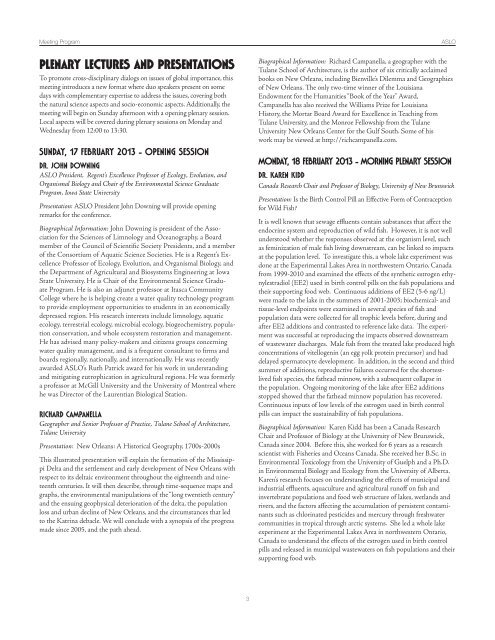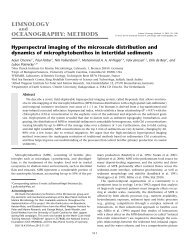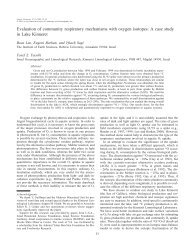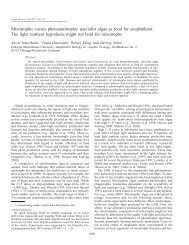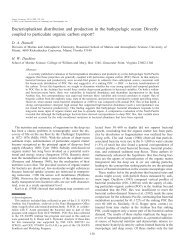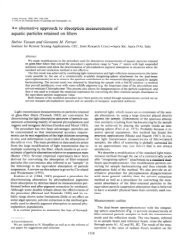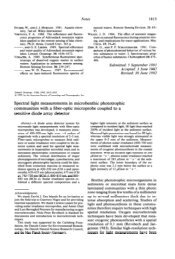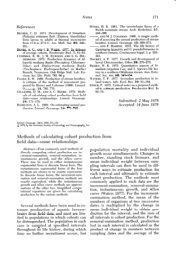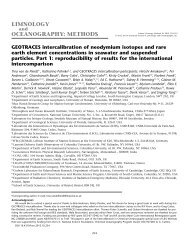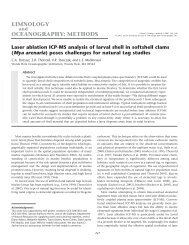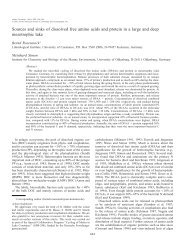CONFERENCE PROGRAM - ASLO
CONFERENCE PROGRAM - ASLO
CONFERENCE PROGRAM - ASLO
Create successful ePaper yourself
Turn your PDF publications into a flip-book with our unique Google optimized e-Paper software.
Meeting Program<br />
PLENARY LECTURES AND PRESENTATIONS<br />
To promote cross-disciplinary dialogs on issues of global importance, this<br />
meeting introduces a new format where duo speakers present on some<br />
days with complementary expertise to address the issues, covering both<br />
the natural science aspects and socio-economic aspects. Additionally, the<br />
meeting will begin on Sunday afternoon with a opening plenary session.<br />
Local aspects will be covered during plenary sessions on Monday and<br />
Wednesday from 12:00 to 13:30.<br />
SUNDAY, 17 FEBRUARY 2013 – OPENING SESSION<br />
DR. JOHN DOWNING<br />
<strong>ASLO</strong> President, Regent’s Excellence Professor of Ecology, Evolution, and<br />
Organismal Biology and Chair of the Environmental Science Graduate<br />
Program, Iowa State University<br />
Presentation: <strong>ASLO</strong> President John Downing will provide opening<br />
remarks for the conference.<br />
Biographical Information: John Downing is president of the Association<br />
for the Sciences of Limnology and Oceanography, a Board<br />
member of the Council of Scientific Society Presidents, and a member<br />
of the Consortium of Aquatic Science Societies. He is a Regent’s Excellence<br />
Professor of Ecology, Evolution, and Organismal Biology, and<br />
the Department of Agricultural and Biosystems Engineering at Iowa<br />
State University. He is Chair of the Environmental Science Graduate<br />
Program. He is also an adjunct professor at Itasca Community<br />
College where he is helping create a water quality technology program<br />
to provide employment opportunities to students in an economically<br />
depressed region. His research interests include limnology, aquatic<br />
ecology, terrestrial ecology, microbial ecology, biogeochemistry, population<br />
conservation, and whole ecosystem restoration and management.<br />
He has advised many policy-makers and citizens groups concerning<br />
water quality management, and is a frequent consultant to firms and<br />
boards regionally, nationally, and internationally. He was recently<br />
awarded <strong>ASLO</strong>’s Ruth Patrick award for his work in understanding<br />
and mitigating eutrophication in agricultural regions. He was formerly<br />
a professor at McGill University and the University of Montreal where<br />
he was Director of the Laurentian Biological Station.<br />
RICHARD CAMPANELLA<br />
Geographer and Senior Professor of Practice, Tulane School of Architecture,<br />
Tulane University<br />
Presentation: New Orleans: A Historical Geography, 1700s-2000s<br />
This illustrated presentation will explain the formation of the Mississippi<br />
Delta and the settlement and early development of New Orleans with<br />
respect to its deltaic environment throughout the eighteenth and nineteenth<br />
centuries. It will then describe, through time-sequence maps and<br />
graphs, the environmental manipulations of the “long twentieth century”<br />
and the ensuing geophysical deterioration of the delta, the population<br />
loss and urban decline of New Orleans, and the circumstances that led<br />
to the Katrina debacle. We will conclude with a synopsis of the progress<br />
made since 2005, and the path ahead.<br />
3<br />
<strong>ASLO</strong><br />
Biographical Information: Richard Campanella, a geographer with the<br />
Tulane School of Architecture, is the author of six critically acclaimed<br />
books on New Orleans, including Bienville’s Dilemma and Geographies<br />
of New Orleans. The only two-time winner of the Louisiana<br />
Endowment for the Humanities “Book of the Year” Award,<br />
Campanella has also received the Williams Prize for Louisiana<br />
History, the Mortar Board Award for Excellence in Teaching from<br />
Tulane University, and the Monroe Fellowship from the Tulane<br />
University New Orleans Center for the Gulf South. Some of his<br />
work may be viewed at http://richcampanella.com.<br />
MONDAY, 18 FEBRUARY 2013 – MORNING PLENARY SESSION<br />
DR. KAREN KIDD<br />
Canada Research Chair and Professor of Biology, University of New Brunswick<br />
Presentation: Is the Birth Control Pill an Effective Form of Contraception<br />
for Wild Fish?<br />
It is well known that sewage effluents contain substances that affect the<br />
endocrine system and reproduction of wild fish. However, it is not well<br />
understood whether the responses observed at the organism level, such<br />
as feminization of male fish living downstream, can be linked to impacts<br />
at the population level. To investigate this, a whole lake experiment was<br />
done at the Experimental Lakes Area in northwestern Ontario, Canada<br />
from 1999-2010 and examined the effects of the synthetic estrogen ethynylestradiol<br />
(EE2) used in birth control pills on the fish populations and<br />
their supporting food web. Continuous additions of EE2 (5-6 ng/L)<br />
were made to the lake in the summers of 2001-2003; biochemical- and<br />
tissue-level endpoints were examined in several species of fish and<br />
population data were collected for all trophic levels before, during and<br />
after EE2 additions and contrasted to reference lake data. The experiment<br />
was successful at reproducing the impacts observed downstream<br />
of wastewater discharges. Male fish from the treated lake produced high<br />
concentrations of vitellogenin (an egg yolk protein precursor) and had<br />
delayed spermatocyte development. In addition, in the second and third<br />
summer of additions, reproductive failures occurred for the shortestlived<br />
fish species, the fathead minnow, with a subsequent collapse in<br />
the population. Ongoing monitoring of the lake after EE2 additions<br />
stopped showed that the fathead minnow population has recovered.<br />
Continuous inputs of low levels of the estrogen used in birth control<br />
pills can impact the sustainability of fish populations.<br />
Biographical Information: Karen Kidd has been a Canada Research<br />
Chair and Professor of Biology at the University of New Brunswick,<br />
Canada since 2004. Before this, she worked for 6 years as a research<br />
scientist with Fisheries and Oceans Canada. She received her B.Sc. in<br />
Environmental Toxicology from the University of Guelph and a Ph.D.<br />
in Environmental Biology and Ecology from the University of Alberta.<br />
Karen’s research focuses on understanding the effects of municipal and<br />
industrial effluents, aquaculture and agricultural runoff on fish and<br />
invertebrate populations and food web structure of lakes, wetlands and<br />
rivers, and the factors affecting the accumulation of persistent contaminants<br />
such as chlorinated pesticides and mercury through freshwater<br />
communities in tropical through arctic systems. She led a whole lake<br />
experiment at the Experimental Lakes Area in northwestern Ontario,<br />
Canada to understand the effects of the estrogen used in birth control<br />
pills and released in municipal wastewaters on fish populations and their<br />
supporting food web.


